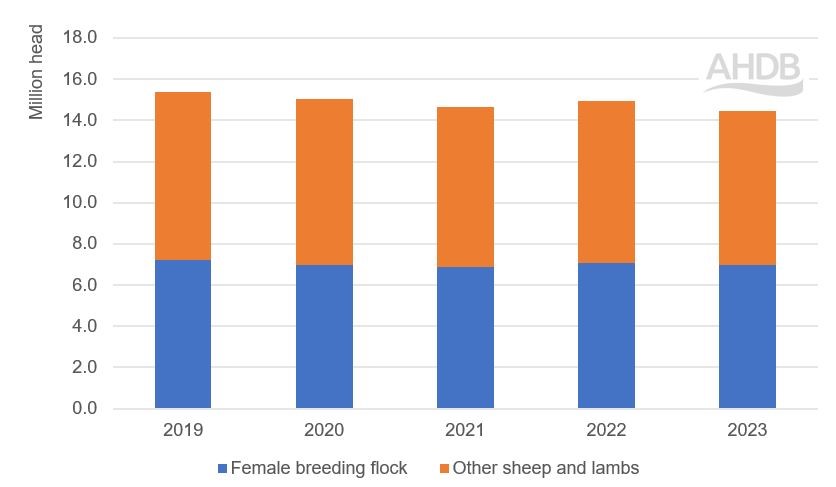- Home
- News
- English sheep flock: Defra’s annual livestock survey shows English flock numbers at the lowest in 12 years
English sheep flock: Defra’s annual livestock survey shows English flock numbers at the lowest in 12 years
Friday, 6 October 2023
Defra’s annual livestock survey shows the English sheep flock declined by 3.2% year on year, totalling 14.5 million head in June 2023. This is the lowest recorded population since 2011.
Key Points
- English sheep flock declined by 3.2% year on year
- Female breeding flock saw a reduction of 116,000 head (-1.6%)
- Reduction of 4.9% (364,000 head) in lambs aged under a year
- We await data from other devolved nations to get a full picture of the UK lamb crop
Overall, the female breeding flock saw a reduction of 116,000 head (-1.6%) to stand at nearly 7.0 million head in June 2023. Looking at this by category, there was a notable increase in breeding ewes intended for slaughter, up 8.8% compared to the same period last year. This was countered by declines in the number of ewes intended for first time breeding (-8.3%) and ewes intended for further breeding (-1.3%). While a decline versus last year, the number of ewes for further and first-time breeding was relatively level with numbers recorded in 2021.
Declines were also seen in the rest of the English flock, driven by a reduction of 4.9% (364,000 head) in lambs aged under a year old, compared to the June 2022 survey. Ram numbers did see a slight increase of 1.2% year-on-year alongside an increase of 3.5% of other sheep 1 year old and over.
These reductions continue the general trend in the total English flock seen since 2017. Industry challenges are well-documented: input cost fluctuation, changes to direct payments, agricultural policy and government support schemes, not least consumer purchasing. GB finished lamb prices have fluctuated but have been relatively firm historically in 2023, especially since early August.
Number of sheep in England 1 June 2023

Source: Defra
Indeed, recent store market price data suggests that store lamb trade is firm at present, with prices above historical averages. Does this suggest some tightness in the market currently, or short-term confidence among producers? The changes in ewe numbers recorded by Defra would suggest that perhaps the outlook for next year is for flock consolidation, although we await data from other devolved nations to see the full UK picture.

Sign up for regular updates
You can subscribe to receive Beef and Lamb market news straight to your inbox. Simply fill in your contact details on our online form.
While AHDB seeks to ensure that the information contained on this webpage is accurate at the time of publication, no warranty is given in respect of the information and data provided. You are responsible for how you use the information. To the maximum extent permitted by law, AHDB accepts no liability for loss, damage or injury howsoever caused or suffered (including that caused by negligence) directly or indirectly in relation to the information or data provided in this publication.
All intellectual property rights in the information and data on this webpage belong to or are licensed by AHDB. You are authorised to use such information for your internal business purposes only and you must not provide this information to any other third parties, including further publication of the information, or for commercial gain in any way whatsoever without the prior written permission of AHDB for each third party disclosure, publication or commercial arrangement. For more information, please see our Terms of Use and Privacy Notice or contact the Director of Corporate Affairs at info@ahdb.org.uk © Agriculture and Horticulture Development Board. All rights reserved.

